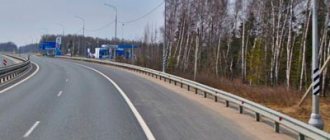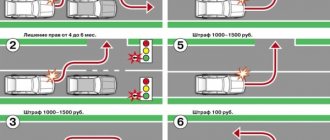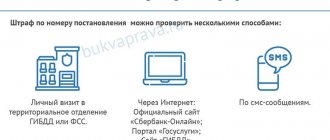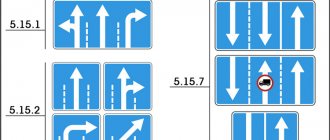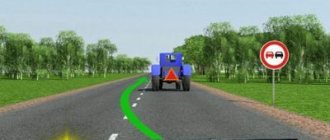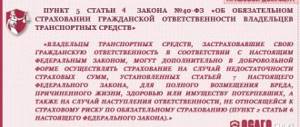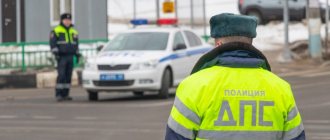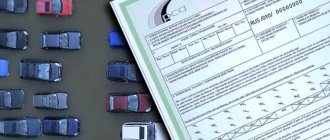The use of paints and varnishes is quite wide and varied. Modern technologies of the chemical industry make it possible to introduce them into more and more different areas, industries and productions. The development of advanced types of surface coating products is of a specialized nature. That is, a specific purpose of paint requires it to have the necessary properties for this purpose. This increases product efficiency, allowing for reduced volumes consumed in the same area as a result of improved material quality and durability.
Road markings in Russia
Thus, money is saved. And this is a very important indicator, especially if the use of paint and varnish products takes place in government affairs, because expenses are covered by allocations from the budget.
There is an expression in Russia that the two main problems that everyone and everywhere encounter are fools and roads. Let's focus on the latter. The condition of the road surface along its entire length leaves much to be desired. There are, of course, individual sections of tracks that meet all the established indicators and do not cause any complaints. But overall the situation is not very good.
This is due to the presence of potholes, uneven surfaces, and incorrect or missing lane markings in some places that motorists should follow. This leads to frequent accidents involving pedestrians, drivers of cars and trucks. The result is harm to the health and lives of people (mild, moderate, severe), causing material damage to the property of owners, blocking traffic flow and many other negative consequences.
One way to partially solve the existing problem regarding markings would be to use high-quality materials from the paint and varnish industry to apply identification elements to the asphalt surface. This is made possible by the creation of tools whose purpose is to exclusively perform this task.
Now let’s take a closer look at each of the questions: about the marking of the road surface, the paintwork materials for its application (characteristics of each type separately), the ways in which this process can be carried out, technical support, conditions that change the state of the paint present on the asphalt surface.
"Road markings": basic provisions
Road marking is a marking made in a certain way and applied to the road surface. Its main function is to inform travelers in order to simplify their movement on a dangerous section of the route.
This concept is found quite often in the Rules of the Road. It also proposes its division into two types and the characteristics of each. There are horizontal and vertical markings depending on which surface (horizontal or vertical) the paint coating is applied to.
The application process is regulated by a number of legal acts. Among them are various GOSTs and departmental regulations on construction. For example, GOST R 51256-99.
The quality level of painted traffic lanes is also determined by the indicators of the paint and varnish product, its main features, and the impact of various factors directly during its operation.
"TechnoNIKOL AK" (enamel)
This road marking paint is a one-component cold-applied paint material. It contains highly dispersed pigments and fillers.
Technicol does not need to be diluted, so it is completely ready for use. With its help, you can apply horizontal markings on the roadway, asphalt and concrete surfaces. The paint is supplied in several modifications, specifically designed for the scope of application - these can be federal, regional or intermunicipal roads, as well as other roads and sidewalks.
The recommended consumption of this paint is from 400 g/m² to 700 g/m², depending on the type of base.
Paint for road markings
Substances for asphalt surfaces are conventionally divided into two categories:
- Used in most cases. Among them are specialized paints, characterized by particular resistance, and a group of plastics. A big role is given to paints and thermoplastics.
- Used in certain situations. These are paving stones (made of clinker or ceramics), chips (made of porcelain), concrete (made of cement, asphalt or polymer), buttons (made of metal) and individual blocks.
Paints and varnishes for road surfaces are multicomponent mixtures. They contain 4 or more components: pigments, polymers, additives, fillers. The most important element that determines the quality of markings and its durability is the polymer.
The quality of the drawn lines also depends on the paint application technology. There are two ways: cold and hot. Some paint materials can only be applied in a certain way. The first method allows you not to renew the coating for up to two years. The second is often used on road sites with high speed limits (highways and highways). There is another fairly common group of products that provide light reflection.
Noise strip technology
Meanwhile, there is a technology for applying longitudinal noise stripes that avoids the risk of coating destruction. Another beauty of it is that the noise strip fits perfectly into the size of a regular dividing strip. Of course, she is one herself, also fulfilling the role of noise. It’s funny to say that you don’t need to attract any additional resources to apply noise markings - the operation is already included in the budget of the organization operating the road.
There are requirements regulating this technology. According to the technical requirements for road markings on public roads, prescribed in the interstate standard GOST 32953–2014, horizontal markings based on surface properties are divided into markings without a structural and profile surface and markings with a structural or profile surface (in other words, noise). Marking with a structured surface is made “from individual fragments, the degree of filling of the lines when applied is from 25 to 75% and a thickness of at least 1 mm.” Markings with a profile surface are applied “with alternating protrusions of various shapes, the degree of line filling of which during application is 100%.” As stated in GOST, “horizontal markings with a structural and profile surface provide a vibration (noise) effect on vehicle drivers, informing them about a collision with this marking.”
Technical conditions for noise strips on public roads are determined in GOST 33025–2014. According to the type of material used and the technology of the device, according to this standard, the noise strip is divided into those made of thermoplastics and cold plastics for horizontal road markings with a reflective surface, or made of colored anti-slip coatings, or by milling the road surface. The note notes that thermoplastics, cold plastics and colored anti-slip coatings are used to construct transverse noise strips. However, the next paragraph of the standard states: “the use of other materials and technologies for the manufacture of noise strips that ensure compliance with the requirements of this standard is permitted.” At the same time, “to ensure road safety through visual and vibration effects, it is allowed to use horizontal road markings with a structural and profile surface in accordance with GOST 32953 for the installation of longitudinal noise strips.” Thus, the standard allows the use of horizontal markings with a structural and profile surface as a longitudinal noise strip.
Cold method and corresponding paintwork materials
Three groups of paint and varnish coatings are applied in this way:
- Paints containing organic solvents;
- Water-dispersed;
- Cold plastic.
The first type of materials is represented mainly by waterproof paint products. Previously, EP-5155 enamel was used, but its properties were inferior to foreign samples. The experience of other countries and our developments were taken into account and a new type of paint was born - WMD (waterproof road marking).
The second type is distinguished by an increased level of environmental safety, which sets it apart from other “brothers”. However, this also has its drawbacks: a long drying time for the surface, low durability during the operation of the road surface.
Cold plastic significantly improves the last mentioned fact, extending the service life to two, and in some cases, three years. For comparison: usually horizontal markings require a new application after a year. This species appeared in Russia quite recently.
The group of cold-applied enamels includes, in addition to the previously mentioned number:
- 5155,
- AK-505,
- AS-554,
- EP-5327.
Hot type of application of materials
In some aspects, this method is more effective than the previous one.
Its advantages include:
- Extended service life of hot-applied coatings. This is due to a noticeable thickening of the layer of material used for marking.
- Less time-consuming production thanks to a fully mechanized process.
But there are also quite noticeable weaknesses, one might even say difficulties. First of all, it is a question of price. Hot production is several times more expensive than cold production. Secondly, constant monitoring of the temperature regime in automobile containers with paints and varnishes is necessary. Thirdly, you need special equipment that is designed specifically for this.
It’s easy to guess that the main material intended for this type of application is thermoplastic (“thermo” means heat, heat).
An example of this type of product is thermoplastics:
- "Megoplast"
- "Technoplast"
- TPK,
- TPK-N,
- texture M-1, M-2.
Marking technology
When it comes to applying road markings over large areas, it is worth giving preference to the mechanized method. There are a number of special machines designed for this. Thanks to their use, the level of quality, as well as the correctness of the lines, increases.
Automotive marking equipment must include the following elements:
- technological units;
- temperature control sensors;
- devices for applying lines of various sizes and spraying other components;
- spray nozzles;
- pressure regulator in a container with materials.
Russia usually purchases such equipment from foreign suppliers, who pay closer attention to the development of specialized equipment for applying road markings.
Reflective materials
To make the markings visible on the road, they are made bright and have reflective properties. This will ensure its visibility in bad weather and in the dark. The light of headlights can be reflected, for this purpose glass microbeads are used - they are applied on top of the paint or mixed with it, and sometimes these two methods are used simultaneously. It is advisable that the top layer of the balls is not completely immersed in the liquid, but protrudes 60 percent out of it - this will ensure the best effect.
The diameter of such spheres is 100-160 km, thanks to which they reflect light in any weather.
Factors influencing the roadway
Throughout its service life, the marking line is affected by a number of factors that determine how wear-resistant the coating is. Many studies have been carried out in order to identify them. It was found that the summer season is characterized by less wear of the paint layer than the winter season. This is due to temperature conditions and sharp transmissions in the cold season.
So, what determines how long it takes for information lines to stay on the road?
- The degree of change in the structure of the paint and varnish material itself;
- The degree of change in the structure of the asphalt or concrete pavement;
- The interaction of the applied substance with the one that is being painted;
- Influence of temperature conditions;
- Road congestion with cars (average cross-country ability);
- Other.
The main element in the composition of paints and varnishes is polymer, as it performs a binding, connecting function.
conclusions
As we can see, the market for specialized materials in the paint and varnish industry intended for road markings is very wide. There are both domestic developments (for example, VMD paint) and imported ones.
The situation on the roads largely depends on the properly organized space of the roadway. The effectiveness of the marking process depends on the use of a particular material (priority paint with a narrow focus - only for roads), the method of its application (cold or hot), the equipment used for road work and more.
New developments in the Russian chemical industry will further improve the quality of coatings and increase the degree of adhesion to the road surface. The main area that should be given close attention is increasing the service life of paints and varnishes for road use in order to save the state money. This may also contribute to reaching a higher level of the market in this area and the emergence of a positive trend in sales volumes of paints and varnishes.
How to mark a parking lot
In open and closed parking lots, there must be strict designation of parking spaces, pedestrian crossings, and navigation arrows. Additionally, columns are painted and parking spaces are numbered. All marking principles are standardized by GOST 52289-2004, especially places for people with disabilities.
Standard parameters of a parking space: length - 5 m, width - 2.5 m, 3.6 m - for disabled people . The width of the passage is taken into account - 6 m, the width of the marking lines - 10 cm.
For such work, it is recommended to use road paints, cold or hot plastic, epoxy, and polyurethane paints. Preliminary preparation, measurements and calculation of parking spaces are carried out, taking into account the total area, number of parking spaces, fences and the capabilities of the territory. The coating must be thoroughly cleaned of debris and dirt.
The selected material is applied using special equipment, in rare cases manually . A mandatory condition is to fence the locations of fire extinguishers, exits, and fire hydrants with reflective paints and tapes.
Technical requirements for road marking materials
Table 1. Color coordinates of dried films of paints (enamels), hardened thermoplastics and cold plastics must correspond to these values.
| Color | Chromaticity coordinate notation | Coordinates of the corner points of color areas | |||
| 1 | 2 | 3 | 4 | ||
| White | 0,355 0,355 | 0,305 0,305 | 0,285 0,325 | 0,335 0,375 | |
| Yellow | 0,443 0,399 | 0,545 0,455 | 0,465 0,535 | 0,389 0,431 | |
| Orange | 0,506 0,404 | 0,570 0,429 | 0,610 0,390 | 0,585 0,375 | |
| Black | 0,260 0,310 | 0,345 0,395 | 0,385 0,355 | 0,300 0,270 | |
| Blue | 0,070 0,200 | 0,208 0,272 | 0,225 0,228 | 0,115 0,083 | |
| Note – chromaticity coordinates are not standardized for red. | |||||
Table 2. The brightness coefficient of the dried film of paints (enamels), hardened thermoplastics and cold plastics must correspond to these values.
| Color | Marking material class | Brightness factor bv, %, not less | |
| White | B7 B6 | 80 70 | |
| Yellow | B4 B3 | 50 40 | |
| Orange | B3 B2 | 40 30 | |
| Black | B0 | Not standardized | |
| Blue | B0 | Not standardized | |
| Red | B0 | Not standardized | |
Table 3. The density of road marking materials must correspond to these values.
| Material | Density, g/cm3, not less |
| Paint (enamel) | 1,5 |
| Thermoplastic | 1,9 |
| Cold plastic | 1,8 |
| Spray plastic | 1,7 |
Table 4. Conditional viscosity of paints (enamels) must correspond to the values, taking into account the class that determines the requirements for this parameter.
| Marking material class | Conditional viscosity, s |
| UV2 UV1 | From 120 to 180 inclusive At least 80 |
Table 5. The degree of grinding of paints (enamels) must correspond to the values, taking into account the class that determines the requirements for this parameter.
| Marking material class | Grinding degree, µm |
| SP2 SP1 | Less than 50 From 50 to 70 inclusive |
Table 6. The mass fraction of non-volatile substances of paints (enamels) must correspond to the values, taking into account the class that determines the requirements for this parameter.
| Marking material class | Mass fraction of non-volatile substances, %, not less |
| HB2 HB1 | 75 70 |
Hot marking method
Marking is a process that requires a careful approach to both materials and technologies. In addition to paints and cold plastic, thermoplastic paints and varnishes can be used for these purposes. They are attractive due to the increased thickness of the applied layer and, accordingly, a longer service life. On the other hand, thermoplastics are more expensive, so they are mainly used in areas where wear rates are very high. Such markings are applied exclusively mechanized. Popular thermoplastics include:
- “Marker” is a yellow thermoplastic paint, which is a loose white mixture based on petroleum-polymer resins, plasticizers, synthetic rubber and mineral fillers. Using this composition, you can apply horizontal road markings on roads with heavy traffic and high loads.
- "Megoplast-Premium". This thermoplastic is used for marking center lines, stop lines and arrows on road surfaces. It is highly resistant to temperature changes and abrasion. To apply the material, marking machines are used on a dry surface.
Thermoplastic consumption for a coating 3-5 mm thick is 8-10 kg/m².
